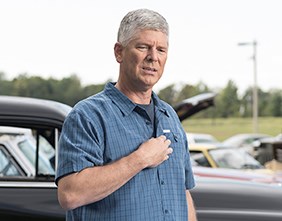Neck Pain and Headaches: Who’s to blame?
posted on: 4/26/2019 3:47:28 PM
Neck Pain and Headaches: Who’s to blame?
Alex Maag, PT, DPT

In my previous article, ‘Back Pain: Who’s to Blame?’, I went into depth about the lifestyle habits that lead to back pain and unique treatment options available to alleviate this nagging issue. In part two, we will move up the chain of the spine to the cervical, or neck region, as well as the head and discuss another area that commonly has issues - neck pain and headaches. As discussed in a previous blog, neck pain and headaches are multifactorial. There is a very long list of issues that could cause or lead to neck pain and headaches. Rather than discuss the just the causes, I will also share what a physical therapist can do to help patients who suffer from problems.
Neck pain and headaches, like lower back pain, can also be attributed to posture and postural asymmetries. Based on demands from society, individuals often find themselves straining forward with their heads and necks while reading their cell phone, tablet or computer screen. You will often find that people bring their shoulders forward or down while performing job duties or home activities. Slumping to one side and tilting your head to the opposite direction is another common theme of habitual poor posture which leads to postural asymmetries.
To help these individuals, physical therapists can utilize treatment approaches focusing on specific postural asymmetries and poor posture in the shoulders, neck and head regions. Furthermore, another cause of neck pain and headaches that I want to dive a little further into is breathing discord.
Through Postural Restoration Institute® training, one learns that there are many components to breathing discord. These include, but are not limited to, asymmetrical breathing patterns, shallow breathing, accessory muscle use, asymmetrical diaphragm utilization, overly passive exhalation and belly breathing. These issues can cause postural asymmetries, increased pain, headaches, shortness of breath, decreased endurance, impaired thought process and increased sympathetic nervous system function.
Poor or asymmetrical posture can affect the position of your diaphragm muscle. For a muscle to work effectively, it must be at a neutral and normal length tension relationship. The posture of your thorax (area between the neck and abdomen) and ribcage can change the length tension relationship of your diaphragm and decrease its ability to function or make it dormant as a muscle. When one or both sides of your diaphragm are not functioning properly, other muscles will kick in to help you breath. These accessory muscles lie in your neck and shoulder girdle region. Overuse of these muscles will create tension, headaches and pain. No matter how hard you try with other forms of treatment, these symptoms will not improve or resolve until postural symmetry and neutrality are achieved and the diaphragm has been restored to a position in which it can work again as a muscle of respiration.
In this instance, the therapists at the Lima Memorial Wellness Center would use a Postural Restoration Institute® approach to treat the postural asymmetry. For these issues, the therapist often utilizes a more manual and hands-on approach to improving postural symmetry. In addition, the therapists also provide handouts with breathing education to educate the patient and make them an informed partner in their care. There are exercises to promote proper position and use of the diaphragm while inhibiting accessory muscle use with breathing. These exercises are simple and can even be done during a patient’s free time or in a work setting. Lifestyle changes will also be key in the treatment of these pathologies.
So, would you have guessed your neck pain and headaches could be a result of decreased function and poor position of your diaphragm? If this is a root or contributing cause to your neck pain and headaches, improvement of this condition from other modes of treatment will be temporary or unsuccessful until the position of the diaphragm is restored and is back to being a primary muscle of respiration. If this is you, I assure you we can help!
Alex Maag, PT, DPT
Alex is a doctor of physical therapy and is the only Postural Restoration Certified Physical Therapist in the State of Ohio. If you suffer from neck pain and headaches and would like more information about how we can help you, contact the Lima Memorial Wellness Center at 419-226-5075.
Website





